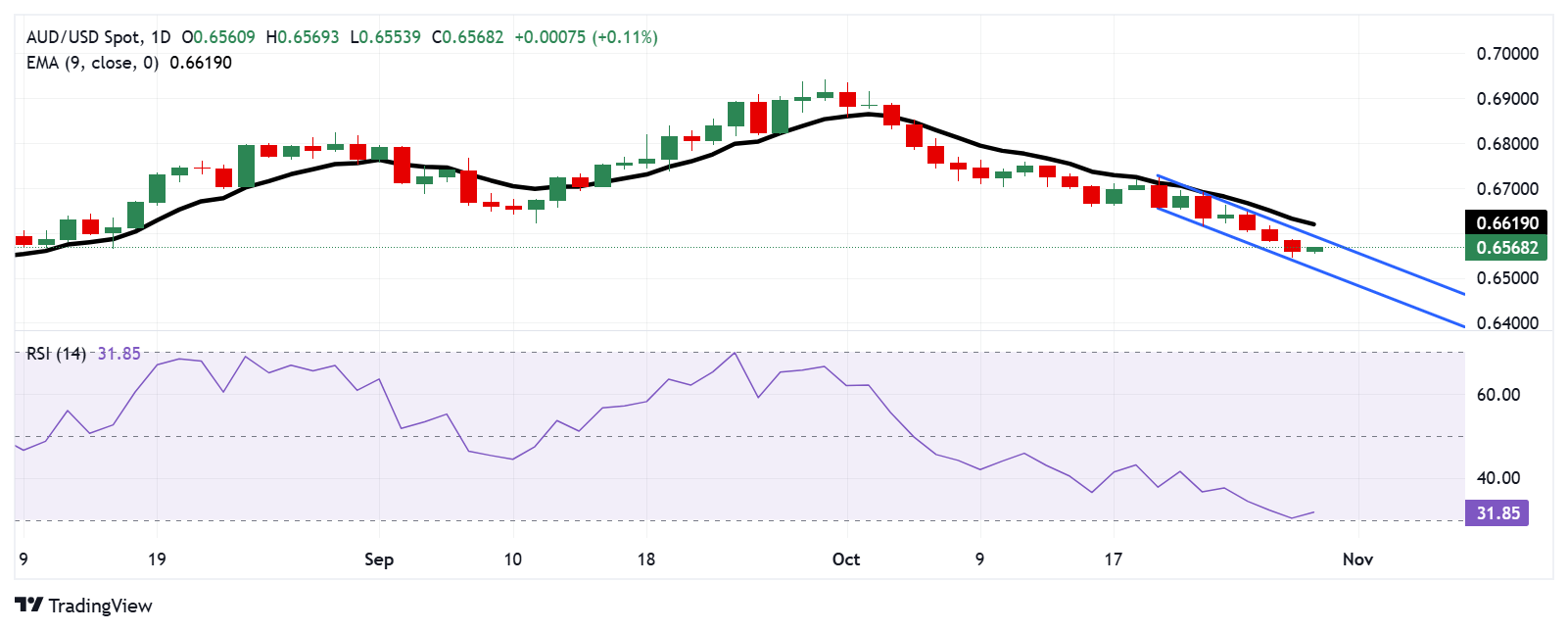Products You May Like
- The Australian Dollar remains steady after a release of lower-than-expected CPI data on Wednesday.
- The monthly Australian CPI rose by 2.1% YoY in September, coming in below the expected 2.3% and previous 2.7% readings.
- The US Dollar may appreciate due to market caution persisting amid uncertainty surrounding the US presidential election and US data.
The Australian Dollar (AUD) holds ground against the US Dollar (USD) despite lower-than-expected Australia’s third-quarter Consumer Price Index (CPI) data released on Wednesday. The upside of the AUD could be attributed to the hawkish sentiment surrounding the Reserve Bank of Australia’s (RBA) regarding its policy outlook.
The Australian Bureau of Statistics reported that the Consumer Price Index (CPI) rose just 0.2% quarter-over-quarter in the third quarter, down from 1.0% in the previous quarter and slightly below the anticipated 0.3%. The monthly CPI rose by 2.1% year-over-year in September, coming in below market expectations of 2.3% and down from August’s reading of 2.7%.
The US Dollar saw a slight downward correction as US Treasury yields edged lower. However, the USD’s downside may be limited, with market caution persisting due to uncertainty surrounding the upcoming US presidential election and anticipation of key US economic data releases.
Traders will likely watch the upcoming release of preliminary US Q3 Gross Domestic Product (GDP) figures and October’s ADP Employment Change, as these could offer important insights into the timing and pace of the Federal Reserve’s (Fed) expected rate cuts.
Daily Digest Market Movers: Australian Dollar inches higher due to hawkish RBA
- The positive US economic data from last week indicates continued resilience in the economy. This supports the sentiment of nominal interest rate cuts by the Federal Reserve (Fed) in November. According to the CME FedWatch Tool, there is a 98.4% probability of a 25-basis-point rate cut by the Fed in November, with no expectation of a more substantial 50-basis-point cut.
- Australia’s CPI fell to 2.8% year-over-year from the prior 3.8%, marking the lowest level since Q1 2021 and coming in below market forecasts of 2.9%.
- The US Bureau of Labor Statistics (BLS) reported on Tuesday that JOLTS Job Openings reached 7.443 million in September, down from 7.861 million in August and falling short of the market expectation of 7.99 million.
- The Reserve Bank of Australia signaled that the current cash rate of 4.35% is sufficiently restrictive to guide inflation back to the target range of 2%-3% while continuing to support employment. As a result, a rate cut in November appears unlikely.
- ANZ-Roy Morgan Australia Consumer Confidence dropped to 86.4 this week, down from 87.5 the previous week.
- Last week, Federal Reserve Bank of San Francisco President Mary Daly stated in a post on the social media platform X that the economy is clearly in a better position, with inflation having fallen significantly and the labor market returning to a more sustainable path.
- RBA Deputy Governor Andrew Hauser highlighted the country’s strong labor participation rate last week and stressed that although the RBA relies on data, it is not overly fixated on it.
Technical Analysis: Australian Dollar remains above 0.6550 within the descending channel
AUD/USD trades near 0.6560 on Wednesday, with daily chart analysis indicating a short-term bearish bias as the pair remains within a descending channel. However, the 14-day Relative Strength Index (RSI) sits at 30, signaling an oversold condition that may lead to an upward correction.
On the support side, the AUD/USD pair could test the descending channel’s lower boundary around 0.6520, followed by the psychological level of 0.6500.
For resistance, the first hurdle lies at the upper boundary of the descending channel near 0.6590, with a psychological level of 0.6600 above that. A breakout above the latter could pave the way for the AUD/USD pair to reach the nine-day Exponential Moving Average (EMA) at 0.6619.
AUD/USD: Daily Chart
Australian Dollar PRICE Today
The table below shows the percentage change of Australian Dollar (AUD) against listed major currencies today. Australian Dollar was the strongest against the New Zealand Dollar.
| USD | EUR | GBP | JPY | CAD | AUD | NZD | CHF | |
|---|---|---|---|---|---|---|---|---|
| USD | 0.00% | 0.05% | 0.02% | 0.02% | 0.06% | 0.08% | 0.03% | |
| EUR | -0.00% | 0.05% | 0.03% | 0.02% | 0.05% | 0.07% | 0.03% | |
| GBP | -0.05% | -0.05% | -0.02% | -0.03% | -0.00% | 0.02% | -0.00% | |
| JPY | -0.02% | -0.03% | 0.02% | -0.00% | 0.03% | 0.04% | 0.01% | |
| CAD | -0.02% | -0.02% | 0.03% | 0.00% | 0.03% | 0.05% | 0.02% | |
| AUD | -0.06% | -0.05% | 0.00% | -0.03% | -0.03% | 0.02% | -0.02% | |
| NZD | -0.08% | -0.07% | -0.02% | -0.04% | -0.05% | -0.02% | -0.03% | |
| CHF | -0.03% | -0.03% | 0.00% | -0.01% | -0.02% | 0.02% | 0.03% |
The heat map shows percentage changes of major currencies against each other. The base currency is picked from the left column, while the quote currency is picked from the top row. For example, if you pick the Australian Dollar from the left column and move along the horizontal line to the US Dollar, the percentage change displayed in the box will represent AUD (base)/USD (quote).
Australian Dollar FAQs
One of the most significant factors for the Australian Dollar (AUD) is the level of interest rates set by the Reserve Bank of Australia (RBA). Because Australia is a resource-rich country another key driver is the price of its biggest export, Iron Ore. The health of the Chinese economy, its largest trading partner, is a factor, as well as inflation in Australia, its growth rate and Trade Balance. Market sentiment – whether investors are taking on more risky assets (risk-on) or seeking safe-havens (risk-off) – is also a factor, with risk-on positive for AUD.
The Reserve Bank of Australia (RBA) influences the Australian Dollar (AUD) by setting the level of interest rates that Australian banks can lend to each other. This influences the level of interest rates in the economy as a whole. The main goal of the RBA is to maintain a stable inflation rate of 2-3% by adjusting interest rates up or down. Relatively high interest rates compared to other major central banks support the AUD, and the opposite for relatively low. The RBA can also use quantitative easing and tightening to influence credit conditions, with the former AUD-negative and the latter AUD-positive.
China is Australia’s largest trading partner so the health of the Chinese economy is a major influence on the value of the Australian Dollar (AUD). When the Chinese economy is doing well it purchases more raw materials, goods and services from Australia, lifting demand for the AUD, and pushing up its value. The opposite is the case when the Chinese economy is not growing as fast as expected. Positive or negative surprises in Chinese growth data, therefore, often have a direct impact on the Australian Dollar and its pairs.
Iron Ore is Australia’s largest export, accounting for $118 billion a year according to data from 2021, with China as its primary destination. The price of Iron Ore, therefore, can be a driver of the Australian Dollar. Generally, if the price of Iron Ore rises, AUD also goes up, as aggregate demand for the currency increases. The opposite is the case if the price of Iron Ore falls. Higher Iron Ore prices also tend to result in a greater likelihood of a positive Trade Balance for Australia, which is also positive of the AUD.
The Trade Balance, which is the difference between what a country earns from its exports versus what it pays for its imports, is another factor that can influence the value of the Australian Dollar. If Australia produces highly sought after exports, then its currency will gain in value purely from the surplus demand created from foreign buyers seeking to purchase its exports versus what it spends to purchase imports. Therefore, a positive net Trade Balance strengthens the AUD, with the opposite effect if the Trade Balance is negative.

